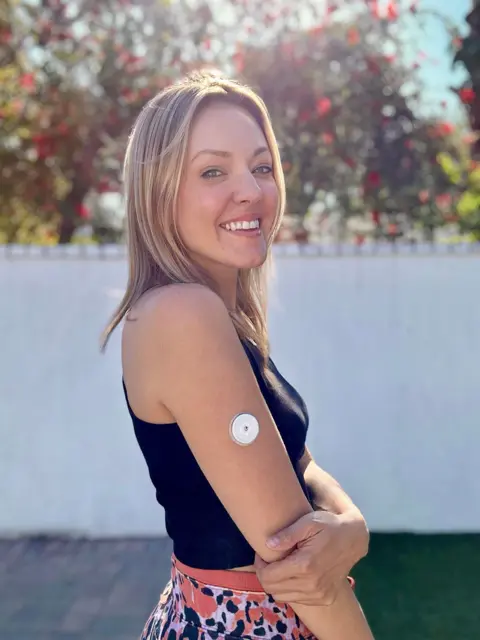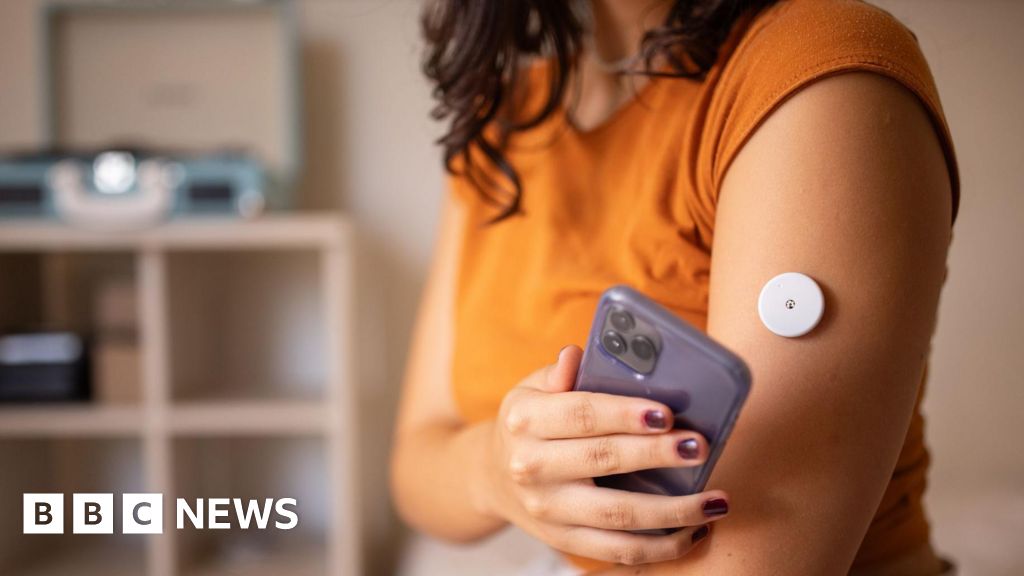By Holly Honderich, BBC News
 Getty Images
Getty ImagesBlood-sugar monitoring devices could soon be on the arms of millions of Americans after regulators cleared two new devices for use without a prescription. Is it a way to improve our health? Or is the data just another distraction?
In the middle of the night last June, Cindy Bekkedam woke up to the sound of an unfamiliar alarm. It was loud, like an emergency alert, and it was coming from her phone. More specifically, it was coming from a newly installed app linked to a glucose sensor embedded in her arm.
According to this app, her blood sugar had dropped to a concerning low while she slept, which had triggered the alarm.
“So I got up in the middle of the night and ate a granola bar,” she said.
Continuous glucose monitors (CGMs), which monitor glucose levels in real time, have been used by millions of diabetics for years. As a dietitian in Ontario, Canada, Ms Bekkedam had hers installed to better understand the technology for her patients with diabetes.
But her two-week trial became somewhat of a cautionary tale.
“I was freaking out,” she said. “I actually questioned, oh my goodness, do I have diabetes?”
She didn’t. And, after some extra research, she found that her glucose levels were entirely normal. But constantly getting updates on her blood sugar highs and lows, without having a medical condition that required it, incited some unnecessary fear.
“That’s where I think people could go down a rabbit hole,” she said.
But these devices may be in the hands – or on the arms – of many more people very soon, thanks to two recent Food and Drug Administration (FDA) approvals for more widespread use. This week, Abbott Laboratories announced it had received federal clearance for two over-the-counter CGMs, including one for those without diabetes.
Use of CGMs is already rising, with the tell-tale arm patches easily spotted during morning commutes in major American cities. But experts say that even if there is no proven harm, there is little evidence to warrant spending the hefty fees – as much as $300 (£240) a month – if you’re not a diabetic.
Abbott’s Lingo, which is a CGM for people without diabetes, is marketed to consumers “who want to better understand and improve their health and wellness”. It was one of two devices cleared by the FDA for sale, and is already available in the UK. The FDA’s 510(k) regulatory process evaluates medical devices for safety and efficacy, but marketing claims are not part of the review.
“Understanding your body’s glucose is key to managing your metabolism so you can live healthier and better,” an Abbott spokesperson told the BBC.
 Getty Images
Getty ImagesAbbott said that flattening glucose curves could help improve energy, mood and sleep and pointed to studies showing the impact of glucose spikes on overall health, and the role of CGMs in monitoring them.
There is scepticism about such claims in the medical community, but one thing experts agree on is that CGMs have significantly improved the care of some people living with diabetes.
Type 1 diabetes is when an individual’s pancreas stops producing insulin, so regular injections are needed. Type 2 diabetes is more common and occurs when the cells in the body become resistant to insulin and so more is needed to keep blood glucose levels within a normal range. It can usually be controlled through medication, diet, exercise and close monitoring, although some take insulin. Traditionally, diabetics monitored their blood sugar with finger-prick tests, but CGMs can alert people with diabetes when their blood sugars are running dangerously high and low, and if insulin needs to be injected.
But many experts say that the evidence for CGMs improving the health of non-diabetics is effectively non-existent. They insist the devices are, at best, a distraction and at worse could lead to dangerous fixations.
A growing trend
CGMs are big business. Market leaders have estimated sales will reach $20bn globally over the next four years.
Earlier this year, the FDA cleared the sale of an over-the-counter CGM made by Dexcom, meant for Type 2 diabetics who don’t use insulin but want to avoid regular finger-prick tests. And some new CGM startups, like Signos, Nutrisense and Levels Health, now market prescription devices off-label as tools for energy, mood and metabolism.
The devices are becoming popular among some in health, wellness and sports industries.
Dutch marathoner Abdi Nageeye, who will compete in the Paris Olympics, told Reuters earlier this week he is wearing a CGM to try to better track his body’s available energy.
 Getty
GettyOthers, including some in the scientific community, have also expressed interest in the effects of glucose on metabolic health.
Nick Norwitz, 28, who graduated from Oxford University with a PhD in nutrition and is currently in his fourth year of medical school at Harvard, said he believes CGMs can be powerful tools because glucose is “a bellwether for what’s happening hormonally in your body”.
He has studied their use while at Harvard, and said he welcomes more research in the field.
Mr Norwitz said he believed that over the long term, the hormonal changes associated with frequent glucose spikes could cause negative effects, including through fat gain.
But, he added, glucose is just one metric, and shouldn’t drive all health decisions.
“To be clear, I don’t think that means if you eat a mango and have your blood sugar go up that it’s ‘worse’ for you than were you to have a plate of bacon,” he said.
Interest in how CGMs can help you change your diet has flourished in some corners of the internet too. Depending on your algorithm, a search for glucose monitors on TikTok or Instagram could lead you to dozens of testimonials from health and wellness influencers espousing the technology’s benefits.
One such influencer, Brittney Bouchard, who promoted a particular CGM start-up on her TikTok and offered her followers a discount code, said wearing a CGM helped her adjust her diet to reduce glucose spikes. She received an affiliate commission when people bought the device through her link.
“I could tell a difference immediately, in my energy, my sleep and my brain fog,” said Ms Bouchard, a 41-year-old health coach from Los Angeles.
 Brittney Bouchard
Brittney BouchardIn her opinion the CGM showed her that her body “was unfortunately very, very sensitive to carbohydrates… even fruit”, she said, recalling that eating a pineapple had made her feel “jittery” and sick.
“If I have oatmeal I will be tired within an hour.”
A solution in search of a problem
But while some researchers and businesses claim that CGMs can have great benefits for the average person, many in the scientific community are sceptical, pointing to a lack of evidence.
Spikes in glucose are a symptom – not a cause – of diabetes, said Oxford researcher and dietitian Dr Nicola Guess. She said there is “no benefit” to CGMs for those who are not diabetic.
“Normally you would identify a problem and invent a solution to fix it,” she told the BBC. “This is backwards. It’s like we’ve got this technology, now we just have to find groups of people who we can convince that they need this technology.”
One key issue experts point to is that it is surprisingly hard to find much data on what blood sugar patterns look like in people without diabetes. This makes it hard to interpret an individual’s results in a meaningful way.
And most people’s sugars will spike with fruit – a food group rich with vitamins and nutrients – but that’s not a reason to stop eating it.
Dr Ethan Weiss, a clinical cardiologist with the University of California, San Francisco, agreed there is scant evidence that tracking glucose levels in people without diabetes can measurably improve their health.
“I’m aware of studies that show you can change your diet and you can decrease glucose spikes. I’m not aware of any studies showing that [tracking glucose] is actually doing anything beneficial, in a meaningful way, like reducing your risk of disease,” he said. “I think mostly it’s the devotees who believe it.”
But, Dr Weiss added, he was not aware of any studies showing the CGMs caused damage, either.
Others, including Dr Guess, said that the potential for harm was very real. Instead of focusing on the foundational building blocks of health – things like regular exercise, and a nutrient-rich diet – trackers like CGMs encourage us to focus on the minutiae of imperfect metrics. And, in worst-case scenarios, they can foster new problems, like disordered eating.
“I worry that instead of doing simple things to improve our health we are turning mealtimes into scientific experiments,” she said.
“I just feel like in some ways people have forgotten the point of living.”



